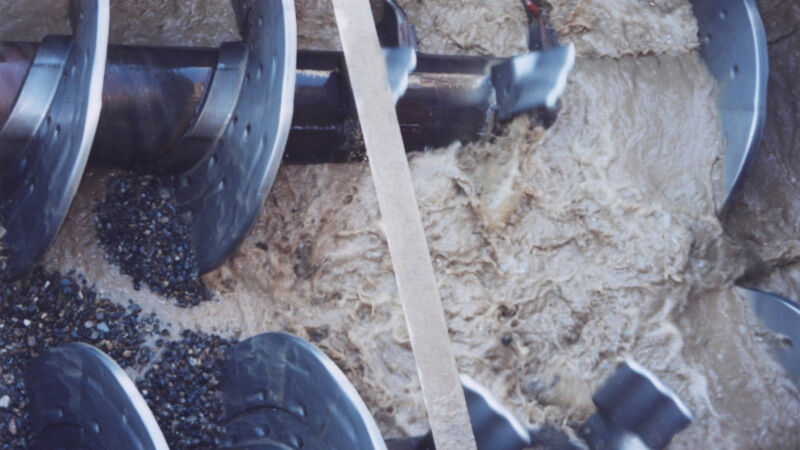
Coarse Material Washers: Not Just for Gravel
Coarse Material Washers are well-known in the aggregate industry for their ability to provide a light to moderate scrubbing of rock. They are mainly used in a typical gravel or limestone washing application to remove water-soluble clays and dust coatings that can ruin the quality of a final product.

While scrubbing is arguably the main reason Coarse Material Washers are used in aggregate applications, they provide another function that lends itself well to non-gravel applications: the ability to float out debris.
One non-gravel application that can benefit from this function of Coarse Material Washers is construction and demolition (C&D) recycling.
C&D waste can contain a variety of building materials from plastic to concrete. The aggregate portion of the waste material can potentially be repurposed for future use, such as a base material, but first the lightweight debris must be removed.
Coarse Material Washers can be used in the wet processing of C&D waste to separate dry, floatable materials such as crushed wood, fiberglass and plastic, from heavier materials such as crushed concrete, crushed concrete block, crushed brick rock, etc.
How Coarse Material Washers work in C&D recycling
Coarse Material Washers consist of a rotating shaft or shafts within a steel tub. The shafts are configured with a row or two of spiral flights followed by several rows of paddles in the feed end and then spiral flights on the remaining length of the shaft. They are powered by a gearbox at the discharge end of the machine.
The paddles on the shafts provide the light scrubbing and washing necessary to remove soluble clays and dust coatings. The paddles also provide a jigging action to float up lightweight, dry and/or nonwaterlogged material to be flushed over by the rising current, which is water that is injected upward into the feed end of the washer tub to help with separating the debris from the product.
The screw flights are then used to convey the material out of the washer tub, providing some dewatering of the material as it travels up the incline toward the discharge.
When the C&D waste enters the Coarse Material Washer, the heavier aggregate-based materials sink to the bottom of the washer tub, while the lightweight materials float to the top and are removed via the overflow. The heavier material is conveyed by the rotating shafts toward the discharge end of the machine.
Optimizing Coarse Material Washers for trash removal
Coarse Material Washers can be optimized specifically for trash removal, starting with the installation.
For washing and scrubbing applications, Coarse Material Washers are installed at a slope of 15 degrees, but for trash removal, such as in C&D applications, Coarse Material Washers are installed slightly steeper at a slope of 18 degrees. This helps the debris float back toward the rear overflow weir.
Also during installation, the feed chute on the conveyor feeding the washer should be directed toward the rear overflow weir for maximum removal of lightweight debris.
Operational best practices for optimum trash removal include using plenty of water to help float the lightweight material out of the Coarse Material Washer.
EIW Coarse Material Washer advantages for C&D
EIW Coarse Material Washers are designed with several features that prove advantageous for debris removal applications like C&D recycling.
First, each EIW Coarse Material Washer is fabricated with a rising current manifold to provide an upward current of water to assist in removing unwanted materials. Deleterious materials of light specific gravity are floated by the rising current of water and the jigging action of the paddles within the tub. The deleterious materials are then removed by the overflowing wastewater.
All EIW Coarse Material Washers are equipped with an adjustable end weir for improving trash removal capabilities. Due to the design of the trash remover end, undesirable material of less density than the product but too heavy to be suspended in water is rolled up the sloping tub end to the overflow. Lowering the weir will allow more debris to be removed, while raising the weir will allow more material to be retained.
A benefit to any application, EIW Coarse Material Washer paddles (on machines with shafts 36” in diameter and smaller) feature a protective wrap-around design to increase wear life. The shaft is protected from wear by heavy-duty cast hubs to which the paddles and flight segments are mounted.
Available as single shaft or double shaft machines, EIW Coarse Material Washers can come equipped with Eagle’s heavy-duty gear reducer or an off-the-shelf Dodge reducer as part of Eagle’s CONDOR line.
Whether you want to remove soluble clays and coatings from your gravel or limestone feed or remove lightweight debris from a C&D recycling feed, a Coarse Material Washer may be the right solution. Call the experts at EIW to discuss your application details today!




